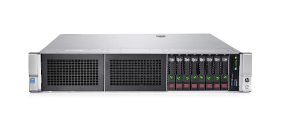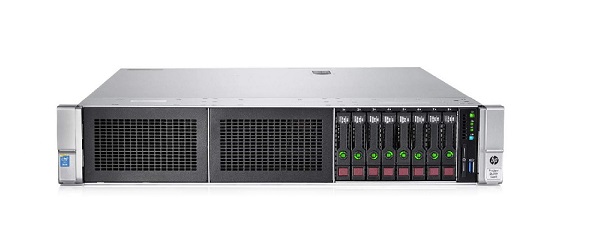HP DL380 Gen9 2U Server

Since HP launched the first rack-mounted ProLiant server in 1998, this year with the launch of Intel’s new generation Xeon E5-2600 v3 series processors, the ninth generation of the ProLiant server series was also released, and the DL380 tested this time Gen9 is the 2-way flagship model with a size of 2U.
The 2U size body can accommodate up to 26 2.5-inch hard drives.
The biggest feature of DL380 Gen9 is that it can accommodate 26 2.5-inch hard drives. If all are 1.6TB, they can be equipped with 41.6T; or 15 3.5-inch hard drives, if all are 6TB, they can be equipped with 90TB. At the same time, the front panel is also designed 1 USB 3.0 port, which is not common in servers with a general 2U size and a panel that can install 24 hard drives.
On the back of this server, there are built-in 2 USB 3.0 ports, 4 GbE network ports, an iLO4 management port, and VGA port. What’s special is that these 4 network ports can choose between two transmission specifications: GbE or 10GbE. That is, users can choose all 4 ports to be GbE, 2 ports to GbE and 2 ports to 10GbE, or all 4 ports to be 10GbE.
Extensive use of tool-free design inside the chassis
In terms of internal components of the fuselage, this server has a total of 2 processors and 24 memory slots built in. The fan design in front of the processor and memory is also quite special. It is similar to the Dell PowerEdge R730 and is a module. The design allows the entire module to be removed, and it also has six built-in cooling fans with a diameter of 8 cm that support heat swapping.
Does this modular design of the fan have specific purposes and needs?
After actual operation and exploration, we found that this design makes sense: except for the appropriate space reserved for the PCIe interface card at the rear of the server, the other spaces are quite compact, so when we want to remove the memory Sometimes, it will be difficult to open the latch on the front of the memory due to the position of the fan. At this time, it will be very convenient to replace the memory as long as the entire fan module is removed.
In addition, DL380 Gen9 inherits the tool-less design of previous HP ProLiant servers. For example, to remove the PCIe lateral riser card, you only need to turn the fixing latch with bare hands and follow the blue icon marked on the riser card to the appropriate position. By applying force, you can quickly remove the horizontal riser card.
Similarly, HP also has a very careful design on the processor socket. If the user needs to replace the processor, as long as the cover of the processor socket pops up, the processor can be directly removed from the pop-up cover. Pull it out, and you don’t have to risk breaking the socket pins. You can take the processor out of the socket, which is very convenient for maintenance and operation.
Low power consumption and stable processor temperature
The DL380 Gen9 tested this time uses two processors: Xeon E5-2640v3. This processor has 8 cores (16 threads) built in. The base clock is 2.6GHz and the overclocked clock can reach 3.4GHz. The thermal design power consumption is 90 watts. In terms of matching memory, it only has four 16GB DDR4 memories installed, and two 2.5-inch SAS hard drives with a capacity of 300GB. There are two power supplies, and their power supply is 500 watts. Meets 80+ Platinum certification.
Under the above configuration, the entire server consumes 75 watts of power in standby, and 207 watts after the processor is fully loaded for a long time. This performance seems to be better than the Taian B7076G62 BV10H with a thermal design power consumption of 85 watts, but in fact it depends on the overall mix, because although the B7076G62 uses a processor with a TDP that is 5 watts less, the installed memory and hard disk are obviously It is much larger than the HP DL380 Gen9, so the power consumption of the DL380 Gen9 is lower, which is expected.
In terms of temperature control, when this server is in standby, the processor temperature is stably controlled at 34 degrees, and after a long period of full load, it increases to 68 degrees. Although the temperature after a long period of full load seems high, it is still within the acceptable operating temperature range of the processor.

